Intresting Facts About Leonardo Da Vinci All the Art of Leonardo Da Vinci
The swell Leonardo da Vinci; if you know anything about art so this is a name you have probably heard quite oft. Recognized equally 1 of the integral pillars of the Italian Renaissance, simply who was the man behind the memorable name? What is Leonardo da Vinci famous for? There are so many questions, and we take the answers! In this article, we will be exploring who this remarkable artist was. If you desire to find out more about the man behind the Mona Lisa, proceed reading, nosotros have some cool Leonardo da Vinci facts to share!
Table of Contents
- one 20 Fascinating Leonardo da Vinci Facts
- 1.ane Da Vinci Was Not His Surname
- 1.2 He Barely Painted
- ane.3 Da Vinci Began His Artistic Training at xiv
- ane.iv He Had No Formal Education
- 1.5 He Was Ambidextrous
- 1.half-dozen War Ruined Da Vinci's Greatest Artwork
- 1.7 He Was an Accomplished Musician
- 1.8 Da Vinci Was Born out of Wedlock
- 1.ix The Human Body Fascinated Him
- i.ten He Worked as an Engineer and Armed services Architect
- 1.11 Beak Gates Is the Proud Owner of Leonardo da Vinci's Notebook
- 1.12 Da Vinci Argued Confronting the Biblical Timetable
- 1.13 Information technology Was a Miracle That Leonardo da Vinci's The Concluding Supper Survived
- i.14 Da Vinci'south Mona Lisa Was Never Finished
- 1.15 Birds and Bats Inspired His Designs of a Flight Car
- one.sixteen He Left Behind a Unmarried Cocky-Portrait
- i.17 Da Vinci Never Married
- i.eighteen He Was Incredibly Innovative
- 1.19 Leonardo da Vinci Figured Out What Makes the Sky Bluish
- i.20 He Left Italy for France and Never Looked Dorsum
- ii Frequently Asked Questions
- two.i Who Was Leonardo da Vinci?
- 2.ii How Did Leonardo da Vinci Die?
- 2.3 What Is Leonardo da Vinci Famous For?
twenty Fascinating Leonardo da Vinci Facts
Nosotros know information technology is of import to cover the nuts when it comes to breaking down an creative person'southward career, tackling questions such as "When was Leonardo da Vinci built-in?" or simply "Who was Leonardo da Vinci?" These questions are all important! Simply da Vinci lived a life littered with accomplishments, not only was he an incredible artist, only he was also a mathematician, engineer, musician, and scientist!
And then, to exercise his life justice, we have put together a list of fascinating Leonardo da Vinci facts that will satisfy your curiosity regarding the famed creative person!
Da Vinci Was Non His Surname
Who was Leonardo da Vinci? Technically, his name indicates that he was Leonardo of Vinci since Da Vinci actually ways "of Vinci". Where was Leonardo da Vinci born? As his name suggests, he was from Vinci, a Tuscan village close to Florence in Italia. According to the modern fashion we think of surnames today, Leonardo did non have a surname.
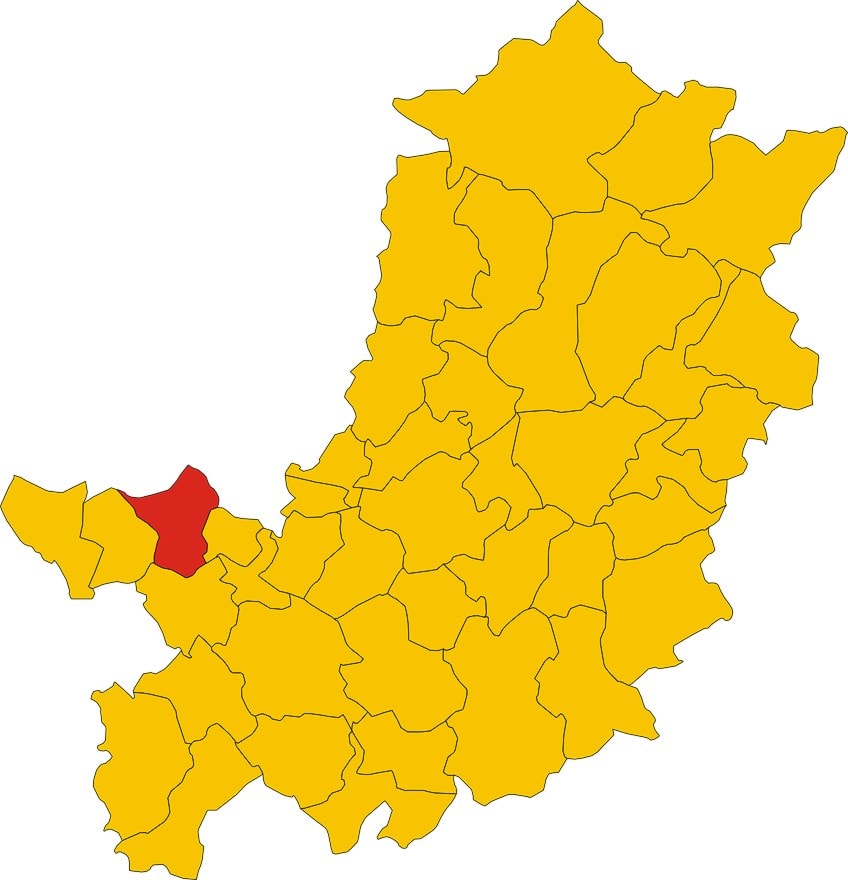 Map of the municipality (comune) of Vinci (province of Florence, region Tuscany, Italy); Vonvikken, Public domain, via Wikimedia Commons
Map of the municipality (comune) of Vinci (province of Florence, region Tuscany, Italy); Vonvikken, Public domain, via Wikimedia Commons
During his lifetime the hereditary surname was more popular amongst the upper class, and information technology but became common practice around the mid-16th century. Technically information technology does not make much sense to just refer to him every bit da Vinci, which is why many academic books and museums refer to him as Leonardo. That beingness said, Leonardo is frequently referred to as da Vinci, so it seems to come down to personal preference.
He Barely Painted
This may exist surprising, but he did not really paint that much. Even though he is notably one of the greatest artists of all fourth dimension, the corporeality of artwork he created is relatively small. There are merely effectually 17 artworks that can be attributed to him that have survived over the centuries. This was in office because of his decorated mind.
Da Vinci was a polymath, which meant he had vast cognition and he was incredibly multi-faceted.
He kept himself occupied with technology matters and his ain scientific inquiry, which meant there were long periods where he was not able to take painting commissions or commit to his art. This speaks to his sheer talent and influence as an creative person, even with such a limited number of artworks he shaped artists that followed and impacted generations to come.
It is important to note that some Leonardo da Vinci artworks did not survive. Several of his famous artworks such as Leda and the Swan (c. 1503 – 1510) and The Boxing of Anghiari (1505) are only known because of his preparatory sketches or from the copies other painters made of them, as they were either lost, deteriorated, or destroyed.
 A sketch of Leda and the Swan by Leonardo da Vinci, c. 1504-1506;Leonardo da Vinci, Public domain, via Wikimedia Commons
A sketch of Leda and the Swan by Leonardo da Vinci, c. 1504-1506;Leonardo da Vinci, Public domain, via Wikimedia Commons
Da Vinci Began His Creative Training at fourteen
Leonardo da Vinci became an apprentice at the age of 14, which was typical for the time. Due to the reputation of his male parent, he started as an amateur to the admired creative person Andrea del Verrocchio. This was where he first learned the basics of drawing, sculpture, painting, technical arts, and engineering.
Non only this, but as well metalworking, metallurgy, chemistry, drafting, and chemistry.
During this fourth dimension, he likewise followed the piece of work of Antonio del Pollauiolo, attending his workshops which were just next door to Verrocchio. At the age of twenty, da Vinci was accepted into the Florence painter's lodge, simply he continued learning nether Verrocchio for the next five years before he branched out on his own.
He Had No Formal Educational activity
This may be quite surprising, given Leonardo da Vinci's mastery of so many subjects, but he did non really receive much of a formal teaching. He did learn the nuts of arithmetic, reading, and writing, but his deep learning only came later in his life. For example, Latin was the language used for academics during this time and da Vinci mostly taught it to himself. Also with advanced mathematics, he began his devotion to the subject when he was in his 30s.
He Was Ambidextrous
Leonardo da Vinci was able to describe forward and backward with both of his hands at the same time. In fact, he wrote most of his learnings from right to left, which produced a mirror script that was not the easiest to read.
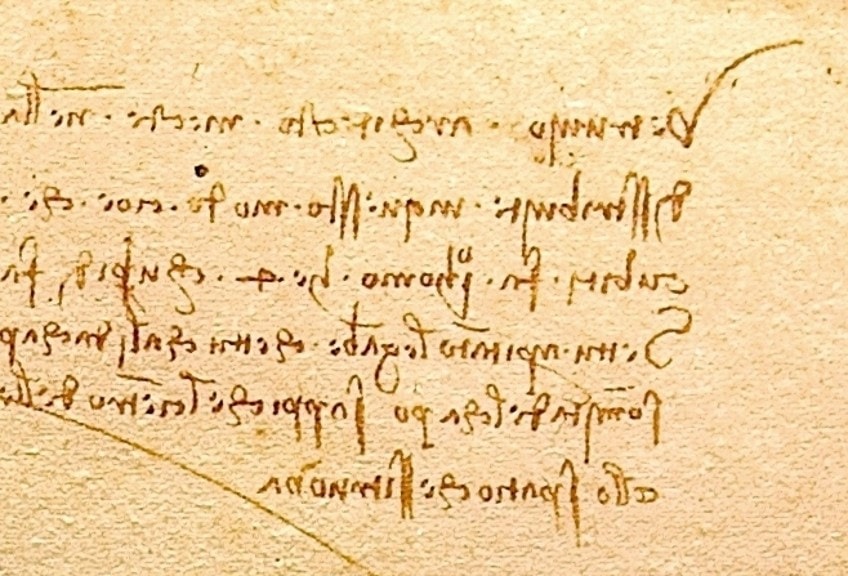 An case of Leonardo da Vinci's mirror writing as seen on his Vitruvian Human being (c. 1492);Leonardo da Vinci, Public domain, via Wikimedia Commons
An case of Leonardo da Vinci's mirror writing as seen on his Vitruvian Human being (c. 1492);Leonardo da Vinci, Public domain, via Wikimedia Commons
Information technology is speculated that his backward-writing was part of his efforts to encode his texts and ideas to forbid them from being stolen. Some other theory is that since he wrote with his left manus, he reversed his writing in an attempt to avert smearing the charcoal, chalk, or wet ink that he was using.
War Ruined Da Vinci's Greatest Artwork
Most everyone will exist familiar with the iconic Leonardo da Vinci artworks such every bit The Concluding Supper (c. 1495 – 1498) and Mona Lisa (c. 1503 – 1506), just arguably his greatest artwork was destroyed by state of war. Da Vinci was supposedly lured to Milan in 1482 to complete a commission of an extensive equestrian statue in award of Francesco Sforza.
On completion, the statue would have been significantly greater in size in comparison to the two existing equestrian statues of the Renaissance period that were made by Verrocchio, da Vinci's mentor, and Donatello.
The statue was commissioned by the Knuckles of Milan, Sforza's son, and it would have towered at over 16 feet tall! Leonardo da Vinci spent 17 years laboring over the projection, which was referred to as Gran Cavallo, significant "Great Equus caballus". To spend this much time on a single projection was not out of the ordinary for da Vinci, given his tendency to go back and forth between various pursuits.
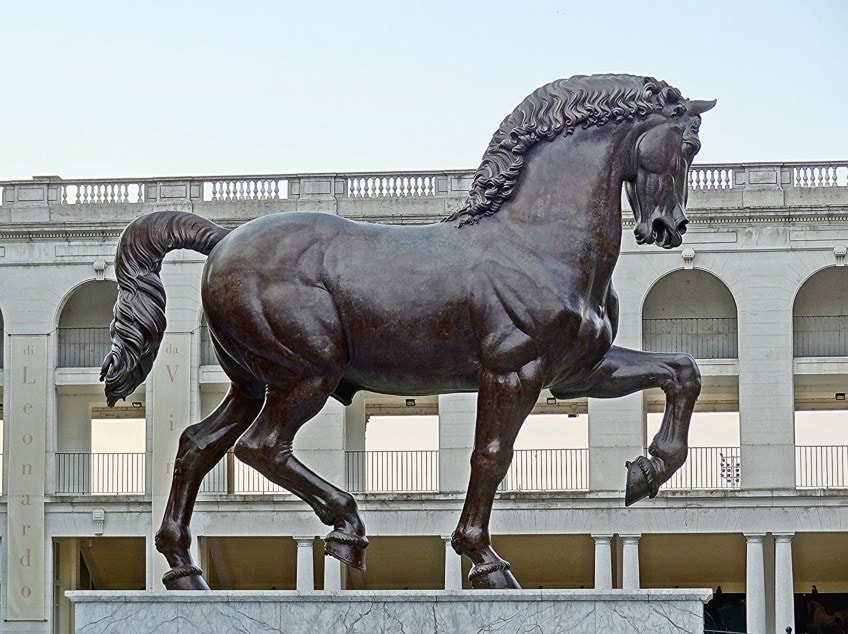 A modern version of Leonardo da Vinci's Gran Cavallo, unveiled on September 10, 1999 at the Hippodrome de San Siro in Milan;Revol Web from Bologna, Italia, CC By-SA ii.0, via Wikimedia Eatables
A modern version of Leonardo da Vinci's Gran Cavallo, unveiled on September 10, 1999 at the Hippodrome de San Siro in Milan;Revol Web from Bologna, Italia, CC By-SA ii.0, via Wikimedia Eatables
Around 1493, da Vinci had planned to cast the clay model in statuary, but he somewhen had to give up because the metal that was meant to be used for the sculpture had been designated for the cannons. This was due to the impending French invasion. As predicted, the French troops seized the city, and the Knuckles of Milan was overthrown.
With that, the dirt model that would have become ane of the greatest monuments of the Renaissance was destroyed.
He Was an Accomplished Musician
Da Vinci'southward artistic genius stretched to music too. He played the flute and the lyre, in addition to singing when he frequented his patrons' palaces and gatherings of the nobility. Some of the manuscripts that take survived the centuries hold his musical compositions likewise. He routinely listened to music when he was painting. He documented how closely related he considered music and the visual arts to be, as they both depended on the input of the 5 senses, except the music was less enduring given that the sound would instantly fade away.
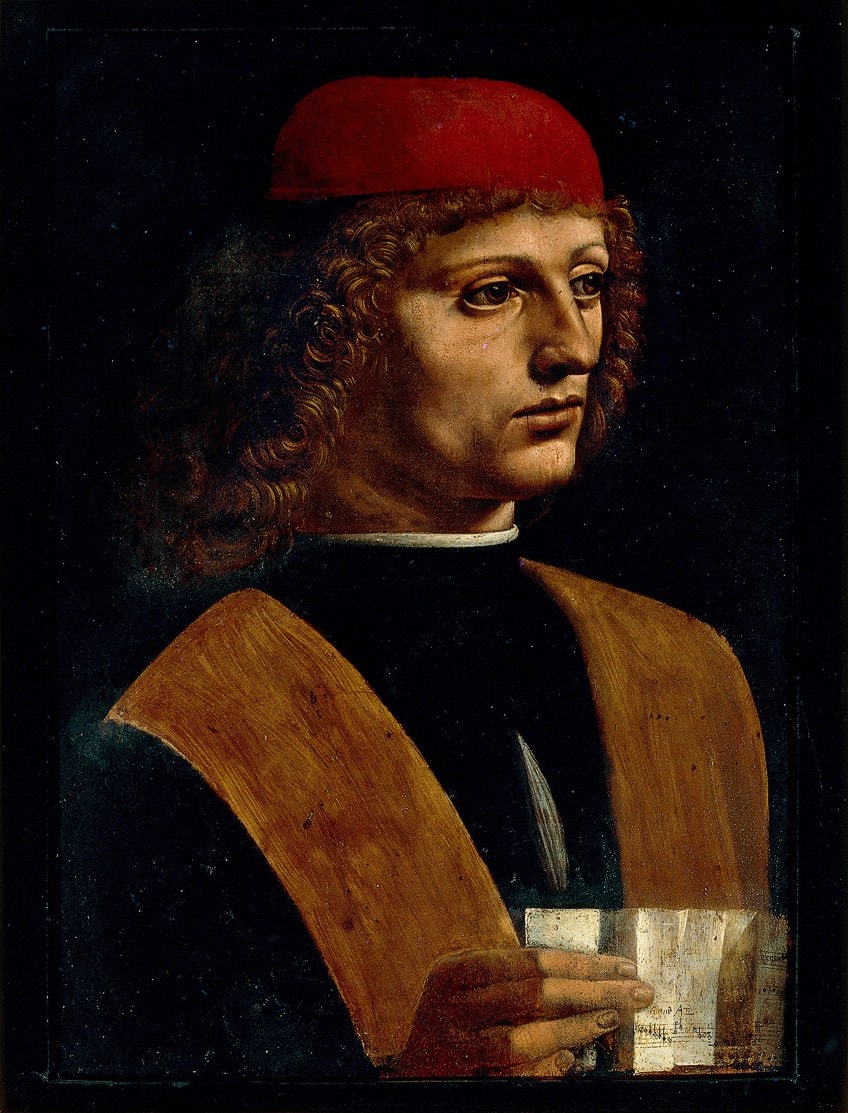 Portrait of a Musician (c. 1483-1487) by Leonardo da Vinci;Leonardo da Vinci, Public domain, via Wikimedia Commons
Portrait of a Musician (c. 1483-1487) by Leonardo da Vinci;Leonardo da Vinci, Public domain, via Wikimedia Commons
Da Vinci Was Born out of Marriage
When was Leonardo da Vinci born? He was born in the twelvemonth 1452, on the 15th of Apr. He was born out of wedlock to a peasant woman called Caterina di Meo Lippi and a respected lawyer called Ser Piero da Vinci. When he was born, until about age v, he lived with his mother, Caterina, in the boondocks of Anchiano, Italy. Then he moved in with his father and they lived in the town of Vinci.
Leonardo da Vinci was best-selling as his father's legitimate child, growing up on his family's estate. He ended up having 12 half-siblings, but because of their drastic age differences, he had very little contact with them.
The Human Body Fascinated Him
Leonardo da Vinci'south vast range of interests and appetite for knowledge included the human torso. He was not content with studying what was available, so he performed man dissections at hospitals in Rome, Florence, and Milan on every bit many equally 30 cadavers. Human being beefcake became a real passion of his, and so much and then that he treated it as its own area of study that was completely contained of the artistic work he did.
His interests inspired him to non only study the structure of anatomy merely to acquit out physiological research.
Leonardo da Vinci'due south drawings that illustrate the body's core equally the centre, lungs, and brain and depict how they function are recognized as significant scientific achievements. Notably, they helped institute the groundwork for modern scientific illustrations.
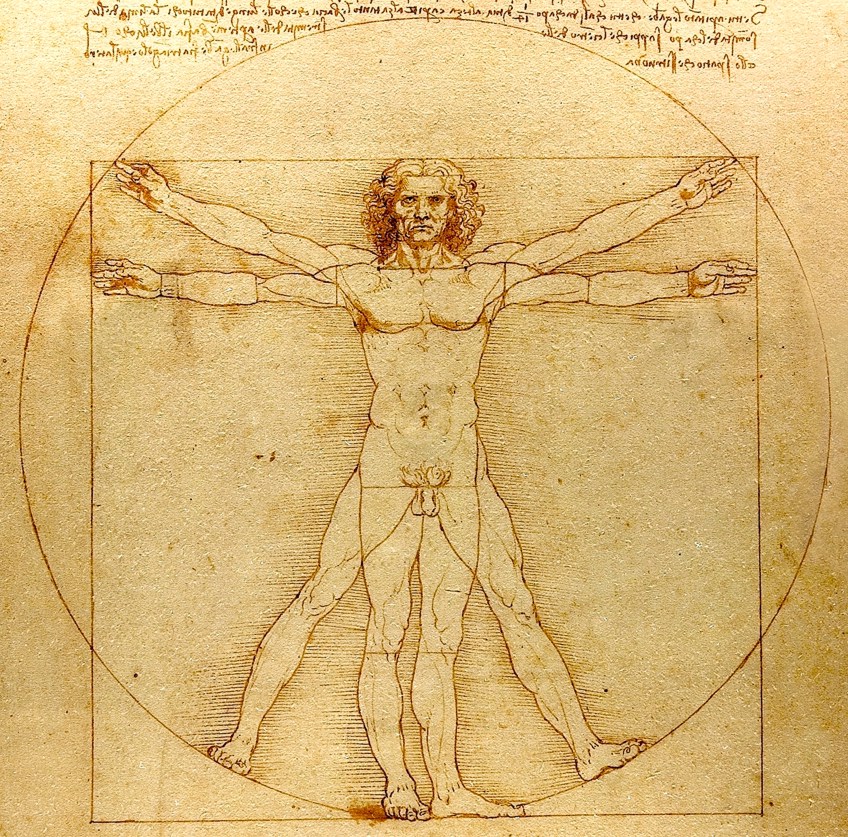 The Vitruvian Man (c. 1492) past Leonardo da Vinci; Leonardo da Vinci, Public domain, via Wikimedia Eatables
The Vitruvian Man (c. 1492) past Leonardo da Vinci; Leonardo da Vinci, Public domain, via Wikimedia Eatables
He Worked as an Engineer and War machine Architect
The son of Pope Alexander Half dozen, Cesare Borgia, was the papal army'southward commander in chief who was notorious for his ruthless methods to maintain command and his efforts to dominate various Italian states. Borgia's unrelenting hunt for power was a major source of inspiration for Niccolò Machiavelli'south political treatise, The Prince, written in the 16th century.
Cesare Borgia arranged for Leonardo to go a general engineer and senior military architect.
This lasted for about ten months. With these titles, Leonardo traveled to and surveyed diverse territories in Borgia. During this fourth dimension, he produced many topographic maps and metropolis plans, which would afterward significantly bear on modern cartography.
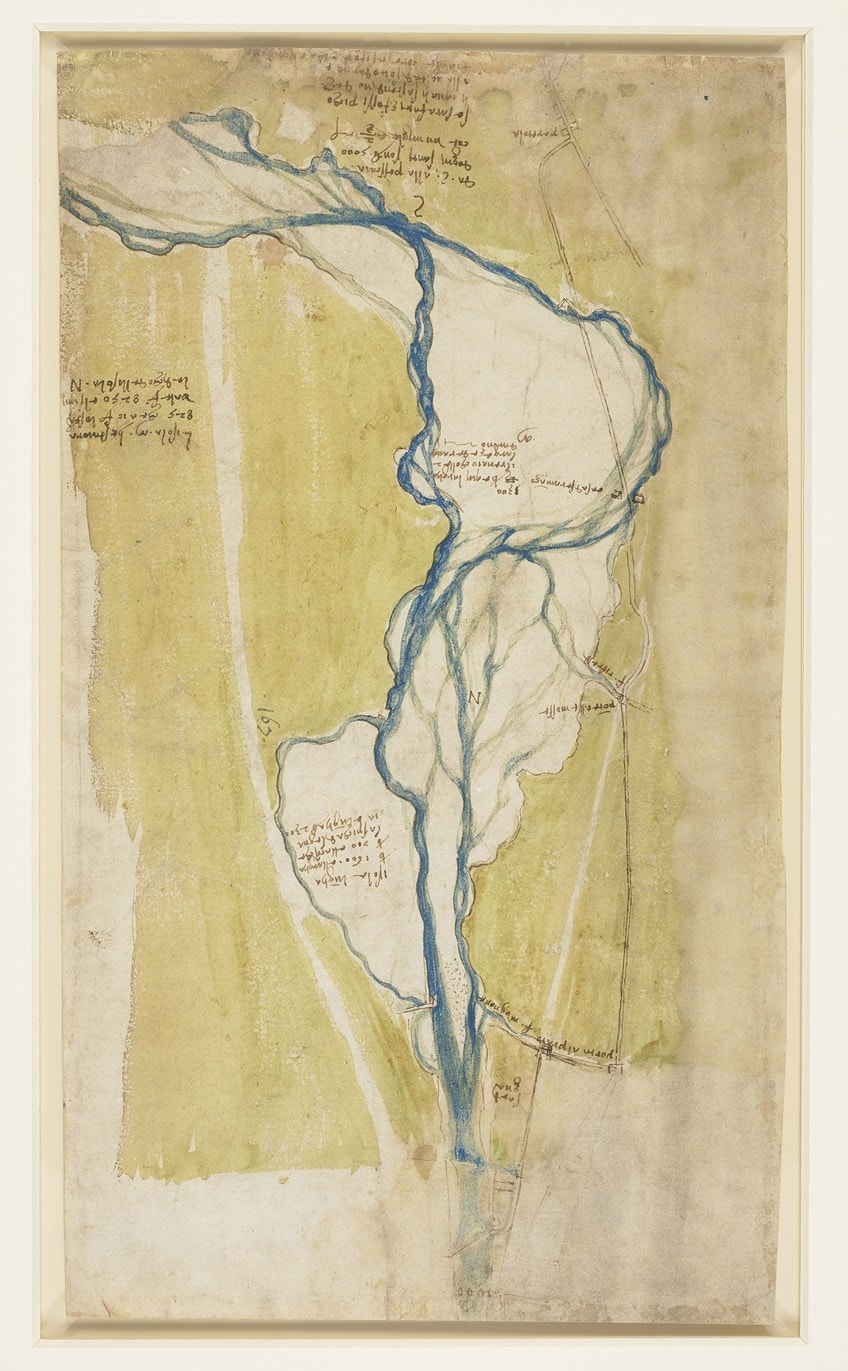 A map by Leonardo da Vinci of the Arno west of Florence, 1504;Leonardo da Vinci, Public domain, via Wikimedia Eatables
A map by Leonardo da Vinci of the Arno west of Florence, 1504;Leonardo da Vinci, Public domain, via Wikimedia Eatables
Bill Gates Is the Proud Owner of Leonardo da Vinci'due south Notebook
What is Leonardo da Vinci famous for? Well, with his inquiring mind, da Vinci fabricated several considerable contributions to the world of art, science, mathematics, and on elevation of that, he was a prolific writer. Many of his notebooks are housed past distinguished institutions such equally the Victoria & Albert Museum and the British Library, but a genius of a different generation was able to snag one of the esteemed notebooks.
Bill Gates purchased da Vinci'south notebook in 1994.
The co-founder of Microsoft paid 30 million dollars for Leonardo's Codex Hammer, also referred to equally Codex Leicester, which was written somewhere betwixt 1506 and 1510. This is the just copy that exists outside of Europe. The notebook is 72 pages long and it contains Leonardo da Vinci'southward scientific musings, where he touches on everything from agreement the motion of h2o to the moon's luminosity and the origin of fossils.
 Pages from Leonardo da Vinci'south Codex Leicester, 1510;Leonardo da Vinci, Public domain, via Wikimedia Commons
Pages from Leonardo da Vinci'south Codex Leicester, 1510;Leonardo da Vinci, Public domain, via Wikimedia Commons
Da Vinci Argued Confronting the Biblical Timetable
According to da Vinci, the Biblical timeline could non business relationship for the geological formations found on the earth'due south surface that are caused by the motion of rivers and sea levels. On the contrary, according to his observations, he proposed that the age of the Earth was significantly greater than the Bible unsaid when taking the features of mountains and the movement of water into consideration. The existence of bounding main fossils on mountainsides was attributed to the receding sea levels as opposed to the Bible's description of a dandy flood.
It Was a Miracle That Leonardo da Vinci's The Last Supper Survived
Afterwards the Mona Lisa (c. 1503 – 1506), The Last Supper (c. 1495 – 1498) might be Leonardo's all-time-known artwork. The beauty of the mural painting was recognized at the time of its debut, with its fascinating limerick. The fact that information technology remains intact at the Convent of Santa Maria delle Grazie in Milan, is somewhat of a miracle.
 The Last Supper (1495-1498) by Leonardo da Vinci;Leonardo da Vinci, Public domain, via Wikimedia Commons
The Last Supper (1495-1498) by Leonardo da Vinci;Leonardo da Vinci, Public domain, via Wikimedia Commons
In 1499, the French invaded Milan and it was suggested that King Louis XII cut down the painting to take with to France, but thankfully this plan was never accomplished. Later in 1796, French soldiers hurled rocks at the painting, putting it nether duress. Then in 1943, the caretakers of the church had to reinforce the wall that had the mural in an attempt to keep it safe from the bombing of the Allied forces.
Although the church faced serious impairment, miraculously, "The Final Supper" was unharmed.
Da Vinci's Mona Lisa Was Never Finished
With da Vinci'south endless pursuits, he was never in whatsoever rush to finish particular projects. Many of his works and paintings were abandoned and considered incomplete. Surprisingly this included his nigh famous painting, The Mona Lisa (c. 1503 – 1506), which remains the earth's about famous painting.
When he passed away in 1519, many of his works were given to his close friend and banana, Salaì, and this included the Mona Lisa (c. 1503 – 1506). Art historians theorized that Leonardo suffered from a debilitating illness that could have paralyzed the right side of his face up, which would take hindered his work in the later years of his life.
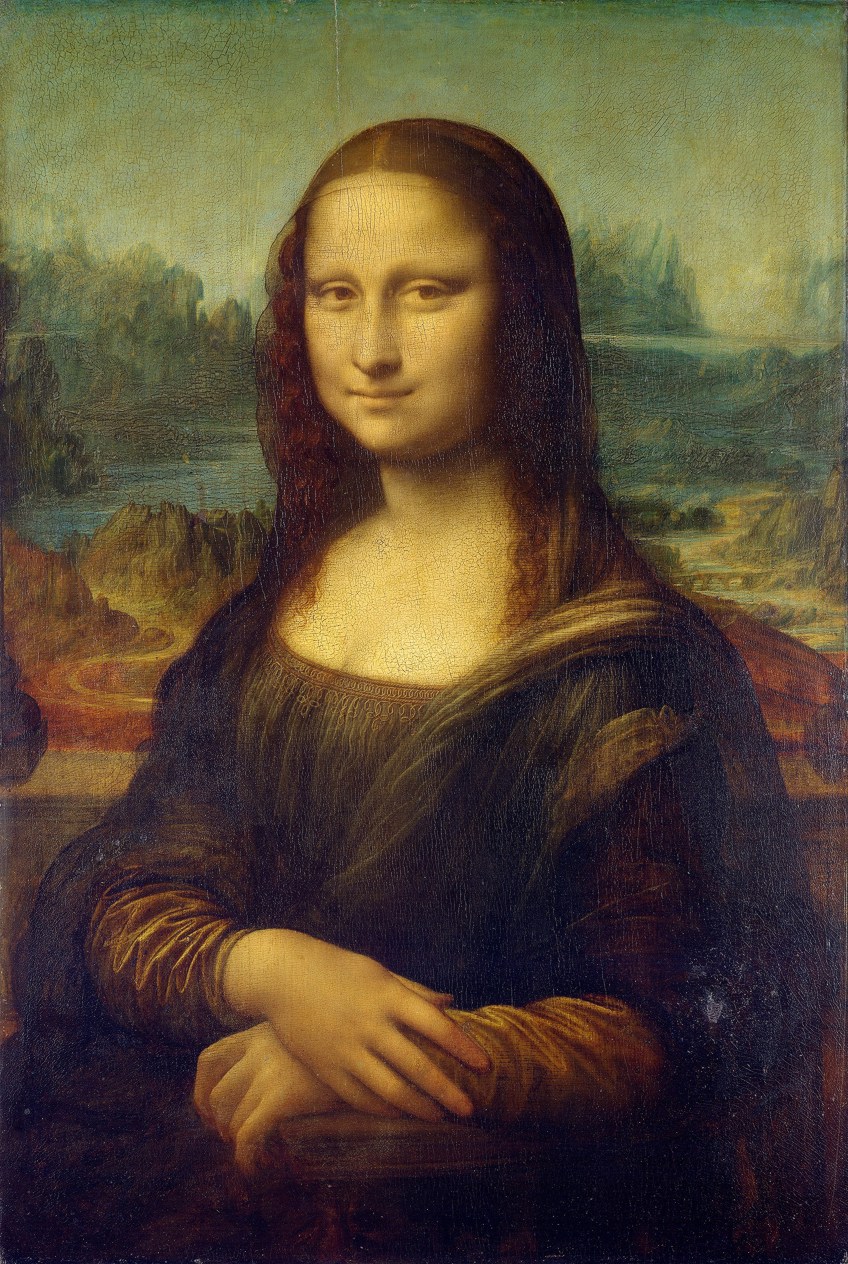 Portrait of Mona Lisa del Giocondo (between 1503 and 1506) by Leonardo da Vinci; Leonardo da Vinci, Public domain, via Wikimedia Commons
Portrait of Mona Lisa del Giocondo (between 1503 and 1506) by Leonardo da Vinci; Leonardo da Vinci, Public domain, via Wikimedia Commons
Birds and Bats Inspired His Designs of a Flying Automobile
Leonardo da Vinci's remarkable achievements as an engineer, scientist, and inventor take left a lasting legacy. According to da Vinci, art and science are securely continued. His ability to use science to view the world in a naturalistic mode, whilst maintaining his artistic eye, encouraged him to exist more expansive with his approach to his observations and manner of thinking.
The combination of his imagination and intellect is what made his ideas possible, such as his designs of a flying automobile that were based on his observations of the flying capability and physiology of birds and bats!
 1 of Leonardo da Vinci's designs for a flying machine, c. 1488;Leonardo da Vinci, Public domain, via Wikimedia Commons
1 of Leonardo da Vinci's designs for a flying machine, c. 1488;Leonardo da Vinci, Public domain, via Wikimedia Commons
Although the machine was never built, even if it had been it is unlikely that it would accept been able to fly, as da Vinci never designed an engine for it. But even so, the world had to look some other 400 years for a machine that could fly!
In addition to a flying machine, Leonardo da Vinci designed 1 of the first parachutes that would have immune someone to spring from any height and country without injury. It was almost 300 years later that someone finally built a practical parachute. Amazingly, in the year 2000, da Vinci'due south design was finally tested and it worked!
Although no show indicates any of his ideas or contraptions were built during his lifetime, his sketches demonstrate that many of his ideas were revolutionary.
He Left Behind a Unmarried Self-Portrait
Countless of Leonardo da Vinci's counterparts and other notable artists left behind many self-portraits, just he completed only one. Leonardo da Vinci artworks only include a single self-portrait, in which he is depicted at historic period 60, titled Portrait of a Man in Red Chalk (c. 1512). The painting now sits in the Royal Library in Turin, Italy.
The image has become quite an iconic representation of Leonardo– an integral pillar of the Italian Renaissance.
 Leonardo da Vinci's presumed self-portrait, c. 1512;Leonardo da Vinci, Public domain, via Wikimedia Commons
Leonardo da Vinci's presumed self-portrait, c. 1512;Leonardo da Vinci, Public domain, via Wikimedia Commons
Da Vinci Never Married
Was Leonardo da Vinci married? The Renaissance man did non marry, although he did develop close relationships with other intellectuals and artists, including his various assistants. However, information technology is presumed that he died on his own. He did develop a special relationship with his banana Francesco Melzi, who was described every bit his pupil and life companion.
Melzi went on to inherit Leonardo's manuscripts, scientific and artistic works and became the executor of Leonardo's manor.
He Was Incredibly Innovative
Leonardo da Vinci was a highly respected Renaissance human. He is credited for several discoveries and inventions in the field of science, many of his ideas and designs were far ahead of his time. In the field of fine art, Leonardo da Vinci artworks are some of the greatest works of art to this day, and he is considered every bit 1 of the greatest artists of all time. In the field of anatomy, his depictions of the human body were by far the most detailed to come out of the 20th century.
 The superficial anatomy of the shoulder and neck (c. 1510-1511) by Leonardo da Vinci;Leonardo da Vinci, Public domain, via Wikimedia Commons
The superficial anatomy of the shoulder and neck (c. 1510-1511) by Leonardo da Vinci;Leonardo da Vinci, Public domain, via Wikimedia Commons
Fifty-fifty his lesser-known innovative accomplishments nevertheless went on to become considerable contributions, later existence put to general use. Thanks to his invention plans, nosotros now have unmarried-span bridges, a caster, a crane, a pile driver, a life preserver, an underwater breathing apparatus, a diving bell, the armored auto, water-powered engines and mills, and a process to concentrate solar power.
Leonardo da Vinci Figured Out What Makes the Heaven Blueish
Leonardo da Vinci'southward keen interest in painting naturally made him enquire about the properties of illumination and low-cal. With his eagerness to learn, he tasked his scientific listen with examining their properties to fully grasp their inner workings. This led him to accurately postulate the reasoning behind the sky's blue hue. Another instance of how he was far ahead of his time, surpassing his peers!
He wrote in one of the many notebooks he kept over his lifetime that the sky's perceived blue color is from the way the sunday illuminates tiny particles of wet that are in the temper.
He Left Italy for France and Never Looked Back
Due to the political upheaval in Milan, Leonardo da Vinci was forced to leave at the historic period of 60. The brother of the Pope, Giuliano de'Medici, hosted the artist in Rome where he hoped to observe piece of work. He received a stipend and was left to his own devices, while his peers which included artists such as Michelangelo and Raphael were completing commissions for the Pope. Da Vinci grew tired of his situation, but subsequently five years he received an offer to work for the King of French republic, which he eagerly accepted. This meant that Leonardo da Vinci would relocate to France.
He left Italian republic in 1516 when he was 65 years one-time and never looked back.
 Le château du Clos Luc in Amboise, the last home of Leonardo de Vinci;Thesupermat, CC Past-SA 4.0, via Wikimedia Eatables
Le château du Clos Luc in Amboise, the last home of Leonardo de Vinci;Thesupermat, CC Past-SA 4.0, via Wikimedia Eatables
Although he did not spend a great deal of fourth dimension on artistic pursuits, he continued working on scientific projects. When did da Vinci die? Sadly, his death followed shortly after his move, dying only a few years afterwards moving to France in 1519. He passed away at his residence, the Château du Clos Lucé in Amboise, France. Simply how did Leonardo da Vinci dice? Although not much is known near Leonardo'due south death, he is presumed to have died of a probable stroke.
The Château d'Amboise's Collegiate Church building of Saint Florentin is where he was buried. Unfortunately, the current location of Leonardo'southward remains is unclear given that the church was destroyed during the French Revolution, which led to its destruction in 1802.
Considering his countless achievements in various fields, from art and design to scientific discipline, engineering, geology, mathematics, cartography, and his scientific research, to name a few– there are and then many fascinating Leonardo da Vinci facts worth mentioning! Our list of Leonardo da Vinci facts gives you an idea of the scope of his vivid mind, but it is certainly not exhaustive of his countless accomplishments! If you are not quite satisfied, there are more articles on our website that explore Leonardo da Vinci's artworks.
Frequently Asked Questions
Who Was Leonardo da Vinci?
When was Leonardo da Vinci built-in? He was born in the year 1452, on the 15th of April. He was born out of wedlock to a peasant adult female chosen Caterina di Meo Lippi and a respected lawyer called Ser Piero da Vinci. Where was Leonardo da Vinci born? As his proper noun suggests, he was from Vinci, a Tuscan village close to Florence in Italy. Leonardo da Vinci was a polymath, which meant that he had a vast scope of cognition. As an artist, engineer, architect, and inventor he epitomized the title of Renaissance man. Throughout his life he presented countless theories and observations that were far ahead of his fourth dimension, many of his contemporaries were unable to comprehend his genius. The combination of his imagination and intellect is what made his ideas possible. Although no evidence indicates any of his ideas or contraptions were built during his lifetime, his sketches demonstrate that many of his ideas were revolutionary.
How Did Leonardo da Vinci Die?
Very petty is known about his death, only the probable cause of his death was likely a stroke. When did Da Vinci die? He died on the second of May in 1519 at the age of 67. He died at his residence, the Château du Clos Lucé in Amboise, French republic. Was Leonardo da Vinci married? He never married, although he did develop close relationships with other intellectuals and artists, including his various assistants, it is presumed that he died on his own. He did develop a special relationship with his assistant Francesco Melzi, who was described every bit his pupil and life companion. Melzi went on to inherit the creative person's manuscripts, scientific and creative works and became the executor of da Vinci's estate afterward his death.
What Is Leonardo da Vinci Famous For?
Well, there is no uncomplicated way of answering this question given his endless lists of pursuits and achievements. More often than not, Leonardo da Vinci is referred to equally nothing short of a genius and the championship fits when yous consider all of his accomplishments! These include his contributions to art, design, geology, mathematics, engineering science, cartography, and his scientific research. Leonardo da Vinci artworks are still recognized as some of the most famous art pieces to always exist, his Mona Lisa (c. 1503 – 1506) is recognized as the nearly famous painting in the earth, and his The Terminal Supper (c. 1495 – 1498) is listed amid the meridian 10 most famous paintings in the earth.
Source: https://artincontext.org/leonardo-da-vinci-facts/
0 Response to "Intresting Facts About Leonardo Da Vinci All the Art of Leonardo Da Vinci"
Post a Comment